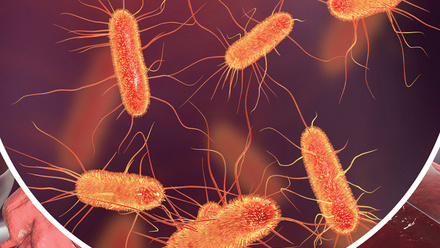Clasado has been a BDA Corporate Member since 2019. BDA corporate members are organisations that strategically work with the BDA and recognise the importance of supporting the dietetic profession. This article has been produced as part of Clasado’s annual corporate membership with the BDA exploring our shared interest in developing engaging and evidence-based communications.
The gut microbiome is fast becoming known as a key player in health and wellbeing. Made up of trillions of microbes, including bacteria, viruses and fungi, the gut microbiome has been shown to influence not only gastrointestinal health, but also immunity and cognitive function3,15, and potentially many other areas of health currently being explored by research. Factors that could support gut health include a balanced diet rich in dietary fibre, participation in regular physical activity and a consistent sleep schedule. However, consuming ‘biotics’, such as probiotics and prebiotics, through food or supplementation, can also be an effective way to further support gut health.11 This can be especially true in the presence of functional gastrointestinal disorders where the gut microbiome could be implicated in the pathophysiology.2 However, whilst many are familiar with probiotics, prebiotics are less well known, with many unclear on the differences between the two. This article aims to answer some of the key questions surrounding probiotics and prebiotics, highlighting the key differences between them and any considerations that should be made when looking to incorporate them into a healthy and balanced diet.
How are probiotics and prebiotics different?
The International Scientific Association for Probiotics and Prebiotics (ISAPP) define probiotics as “live micro-organisms that, when administered in adequate amounts, confer a health benefit on the host”.9 The most highly researched strains of probiotics are those belonging to the Lactobacillus and Bifidobacterium genera. These are usually consumed through supplements or through certain foods, such as live or active cultured dairy products and some fermented foods.
Prebiotics, however, are defined as “a substrate that is selectively utilized by host micro-organisms conferring a health benefit”.8 These are usually fermentable, indigestible carbohydrates, that are often a source of fibre. However, as prebiotics are required to be selective and act as a substrate for specific beneficial bacteria as per the accepted definition, many prebiotics are fibre but not all fibres are considered to be prebiotic.
The current accepted prebiotics are inulin, fructooligosaccharides (FOS) and galactooligosaccharides (GOS). Research suggests other types of prebiotics could exist, however more research is needed to determine their effect on health and thus are considered prebiotic candidates, as opposed to true prebiotics1,5.
Prebiotics differ from probiotics in that they do not contain any live microorganisms and instead act as a food source for the beneficial bacteria already residing in the gut. They can be found in some foods in small amounts such as Jerusalem artichokes, onions, garlic, apples and bananas, but are also commonly consumed through supplements.
What’s the difference in how they work?
Once ingested, probiotics travel through the upper gastrointestinal tract and into the large intestine where they compete with the commensal microbes for nutrients and adhesion sites with the aim to take up residency and proliferate.6
Prebiotics also operate in the large intestine, where they are fermented by beneficial bacteria and stimulate the growth of these microbes by acting as a food source. Prebiotics vary in their degree of polymerization and specificity for certain bacteria, which means some are highly targeted and feed a specific species of bacteria, whereas others can be metabolised by various groups of bacteria.13
What are the benefits?
Both probiotics and prebiotics can contribute to a more favourable composition of the gut microbiota and support a healthy intestinal environment.7 Having a higher quantity of beneficial bacteria is associated with positive health outcomes as the gut microbiota play a key role in supporting many areas of health and wellbeing.4 Consuming probiotics and prebiotics can support the gut microbiome and enhance its ability to:
- Produce short chain fatty acids (SCFAs). SCFAs are metabolites, such as acetate, butyrate, and propionate, that are produced via the fermentation of dietary fibres by bacteria. They are widely studied and have been shown to have anti-inflammatory, immuno-regulatory and potentially even cardio-protective benefits.14
- Biosynthesise certain vitamins, such as B vitamins and vitamin K.
- Facilitate the absorption of some minerals, such as calcium, iron, and magnesium.
- Modulate and maintain the immune system and protect from invading pathogens.
- Support gastrointestinal health by improving stool frequency and consistency as well as reducing functional gastrointestinal symptoms such as bloating, flatulence and abdominal pain.
- Produce neurotransmitters, such as dopamine and serotonin, which affect the brain and can influence mood as part of the bi-directional relationship referred to as the gut-brain axis.
Are there any drawbacks?
For the majority of individuals, there are no major drawbacks to taking probiotics or prebiotics, however there are a few key points to consider:
- Some probiotics lack stability and as a result bacteria can degrade through lengthy storage times, exposure to heat and during transit through the gastrointestinal tract. This means that the full, efficacious dose of bacteria may not make it to the large intestine intact and, as a result, may afford limited benefit. The probiotic intake must also be at least 1 x 109 per day. This can also be the case with some prebiotics. Hence when considering whether to incorporate biotic supplements into the diet it is important to select products backed by credible science.
- Sustained positive changes in the composition of the gut microbiota from consuming probiotics or prebiotics is dependent on consistent, long-term supplementation. The gut microbiota often reverts to its previous composition with cessation of supplementation.
- Probiotics rarely permanently colonise the large intestine and most are therefore dependent on continual supplementation.
- The gut microbiota can be influenced by lifestyle factors such as diet, physical activity, stress and sleep. Imbalances in these areas can contribute towards dysbiosis, whereby there is an imbalance in the gut microflora that could contribute to a range of health conditions. These are areas that should be addressed to further support optimal gut health.
- In some individuals, probiotics and prebiotics can cause side effects such as an increase in stool frequency and bloating. These side effects can be temporary and a result of the biotics taking effect, however, for individuals who are prone to functional gastrointestinal issues, such as IBS, this could be a sign that they are poorly tolerated. Often, these individuals may need to incorporate these supplements gradually. If a gradual introduction fails to ease these issues, it may be that they are not suitable for the individual.
- Research suggests that plant-based prebiotics may not be as well tolerated compared to prebiotics derived from animal products, such as milk, as they often require a higher dose which can exacerbate gastrointestinal symptoms.12
Can they be used together?
Probiotic and prebiotic supplements can be used together and there is no need to choose one over the other. However, those with sensitivity may prefer to opt for just one supplement or introduce one for a certain time period before incorporating the other.
Many refer to the combination of a probiotic and prebiotic together as a synbiotic, however, the definition of a synbiotic is more complex than this. ISAPP define a synbiotic as “a mixture comprising live microorganisms and substrate(s) selectively utilized by host microorganisms that confers a health benefit on the host”, and state that probiotics and prebiotics cannot be called synbiotics unless they have been tested together.10
The takeaway
Research suggests that probiotics and prebiotics have the potential to support a preferential composition of the gut microbiota, which could have far-reaching health benefits that extend beyond gastrointestinal health. They can be found in dietary sources but are commonly consumed through food supplements. Biotics are generally well tolerated and safe to consume by most individuals, however, when considering their suitability, this should be done on an individual basis and under the guidance of an appropriate healthcare provider. When looking to incorporate a commercial supplement, healthcare providers should opt for those backed by credible science.
Read the BDA’s Probiotics and gut health food fact sheet to learn more about what probiotics are, how they work and the impact they could have on wellbeing
References
- Bamigbade, G.B., Subhash, A.J., Kamal-Eldin, A., Nyström, L. and Ayyash, M. (2022). An Updated Review on Prebiotics: Insights on Potentials of Food Seeds Waste as Source of Potential Prebiotics. Molecules, [online] 27(18), p.5947. Available at: https://www.ncbi.nlm.nih.gov/pmc/articles/PMC9505924/.
- Carco, C., Young, W., Gearry, R.B., Talley, N.J., McNabb, W.C. and Roy, N.C. (2020). Increasing Evidence That Irritable Bowel Syndrome and Functional Gastrointestinal Disorders Have a Microbial Pathogenesis. Frontiers in Cellular and Infection Microbiology, [online] 10. Available at: https://www.frontiersin.org/articles/10.3389/fcimb.2020.00468/full.
- Cryan, J.F., O’Riordan, K.J., Cowan, C.S.M., Sandhu, K.V., Bastiaanssen, T.F.S., Boehme, M., Codagnone, M.G., Cussotto, S., Fulling, C., Golubeva, A.V., Guzzetta, K.E., Jaggar, M., Long-Smith, C.M., Lyte, J.M., Martin, J.A., Molinero-Perez, A., Moloney, G., Morelli, E., Morillas, E. and O’Connor, R. (2019). The Microbiota-Gut-Brain Axis. Physiological Reviews, [online] 99(4), pp.1877–2013. Available at: https://pubmed.ncbi.nlm.nih.gov/31460832/.
- Dilip, K., Sumner, R. and Lippmann, S. (2019). Gut Microbiota and Health. Postgraduate Medicine, [online] 132(3), pp.274–274. Available at: https://www.tandfonline.com/doi/full/10.1080/00325481.2019.1662711.
- Gibson, G.R., Hutkins, R., Sanders, M.E., Prescott, S.L., Reimer, R.A., Salminen, S.J., Scott, K., Stanton, C., Swanson, K.S., Cani, P.D., Verbeke, K. and Reid, G. (2017). Expert consensus document: The International Scientific Association for Probiotics and Prebiotics (ISAPP) consensus statement on the definition and scope of prebiotics. Nature Reviews Gastroenterology & Hepatology, [online] 14(8). Available at: https://www.nature.com/articles/nrgastro.2017.75.
- Han, S., Lu, Y., Xie, J., Fei, Y., Zheng, G., Wang, Z., Liu, J., Lv, L., Ling, Z., Berglund, B., Yao, M. and Li, L. (2021). Probiotic Gastrointestinal Transit and Colonization after Oral Administration: a Long Journey. Frontiers in Cellular and Infection Microbiology, [online] 11. Available at: https://www.frontiersin.org/articles/10.3389/fcimb.2021.609722/full.
- Hasan, N. and Yang, H. (2019). Factors affecting the composition of the gut microbiota, and its modulation. PeerJ, [online] 7, p.e7502. Available at: https://www.ncbi.nlm.nih.gov/pmc/articles/PMC6699480/.
- ISAPP (2018a). Prebiotics. [online] International Scientific Association for Probiotics and Prebiotics (ISAPP). Available at: https://isappscience.org/for-scientists/resources/prebiotics/.
- ISAPP (2018b). Probiotics. [online] International Scientific Association for Probiotics and Prebiotics (ISAPP). Available at: https://isappscience.org/for-scientists/resources/probiotics/.
- ISAPP (2020). What makes a synbiotic? ISAPP provides a sneak peek at the forthcoming international scientific consensus definition. [online] International Scientific Association for Probiotics and Prebiotics (ISAPP). Available at: https://isappscience.org/what-makes-a-synbiotic-isapp-provides-a-sneak-peek-at-the-forthcoming-international-scientific-consensus-definition/.
- Redondo-Useros, N., Nova, E., González-Zancada, N., Díaz, L.E., Gómez-Martínez, S. and Marcos, A. (2020). Microbiota and Lifestyle: a Special Focus on Diet. Nutrients, [online] 12(6), p.1776. Available at: https://www.mdpi.com/2072-6643/12/6/1776.
- Vulevic, J., Tzortzis, G., Juric, A. and Gibson, G.R. (2018). Effect of a prebiotic galactooligosaccharide mixture (B-GOS®) on gastrointestinal symptoms in adults selected from a general population who suffer with bloating, abdominal pain, or flatulence. Neurogastroenterology & Motility, [online] 30(11). Available at: https://onlinelibrary.wiley.com/doi/full/10.1111/nmo.13440.
- Wang, S., Xiao, Y., Tian, F., Zhao, J., Zhang, H., Zhai, Q. and Chen, W. (2020). Rational use of prebiotics for gut microbiota alterations: Specific bacterial phylotypes and related mechanisms. Journal of Functional Foods, [online] 66, p.103838. Available at: https://www.sciencedirect.com/science/article/pii/S1756464620300621.
- Xiong, R.-G., Zhou, D.-D., Wu, S.-X., Huang, S.-Y., Saimaiti, A., Yang, Z.-J., Shang, A., Zhao, C.-N., Gan, R.-Y. and Li, H.-B. (2022). Health Benefits and Side Effects of Short-Chain Fatty Acids. Foods, [online] 11(18), p.2863. Available at: https://www.ncbi.nlm.nih.gov/pmc/articles/PMC9498509/.
- Yoo, J., Groer, M., Dutra, S., Sarkar, A. and McSkimming, D. (2020). Gut Microbiota and Immune System Interactions. Microorganisms, [online] 8(10), p.1587. Available at: https://www.mdpi.com/2076-2607/8/10/1587.







